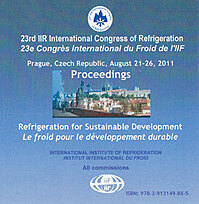
Document IIF
Modélisation de l'efficacité énergétique et du climat intérieur de systèmes de ventilation à l'aide du logiciel ContamW (II).
Energy efficiency and indoor climate modelling of ventilation systems using ContamW (II).
Numéro : pap. ID: 439
Auteurs : JUSTO ALONSO M., MALVIK B., MATHISEN H. M., et al.
Résumé
Residential buildings will become more energy efficient by minimizing air leakages and increasing insulation. However, very airtight houses may have a negative impact on indoor air quality (IAQ) if not properly ventilated. In order to achieve a further reduction in energy use, the focus must be on energy efficient ventilation and heat recovery. In order to predict the effect of alternative solutions for ventilation, it was decided to use ContamW; a simulation software program for estimating concentrations of pollutants and ventilation requirements based on e.g. pollutant source strengths, number of occupants, their presence, and their activities. For this study, a model apartment has been designed. Relevant sources of contaminants like VOC, radon, formaldehyde and NH3 have been implemented and individual presence schedules are included. Performed simulations based on three ventilation strategies indicate that Demand controlled ventilation based on indoor air quality parameters such as CO2 and humidity will provide the best IAQ at the lowest energy consumption.
Documents disponibles
Format PDF
Pages : 8 p.
Disponible
Prix public
20 €
Prix membre*
Gratuit
* meilleur tarif applicable selon le type d'adhésion (voir le détail des avantages des adhésions individuelles et collectives)
Détails
- Titre original : Energy efficiency and indoor climate modelling of ventilation systems using ContamW (II).
- Identifiant de la fiche : 30003003
- Langues : Anglais
- Source : Proceedings of the 23rd IIR International Congress of Refrigeration: Prague, Czech Republic, August 21-26, 2011. Overarching theme: Refrigeration for Sustainable Development.
- Date d'édition : 21/08/2011
Liens
Voir d'autres communications du même compte rendu (569)
Voir le compte rendu de la conférence
-
On-line outdoor air flow control by estimating ...
- Auteurs : WANG S., JIN X.
- Date : 1997
- Langues : Anglais
- Source : International Symposium on Air Conditioning in High Rise Buildings - 1997
- Formats : PDF
Voir la fiche
-
Stratum ventilation: a solution to elevated roo...
- Auteurs : LIN Z., FONG M. L., WANG J.
- Date : 16/06/2013
- Langues : Anglais
- Source : Clima 2013. 11th REHVA World Congress and 8th International Conference on Indoor Air Quality, Ventilation and Energy Conservation in Buildings.
- Formats : PDF
Voir la fiche
-
Energy efficient ventilation systems.
- Auteurs : TIMÁR G.
- Date : 10/06/2007
- Langues : Anglais
- Source : Clima 2007. WellBeing Indoors. Proceedings of the 9th REHVA World Congress [CD-ROM + Abstract book].
Voir la fiche
-
Long term monitoring of residential heat recove...
- Auteurs : CREMERS B.
- Date : 16/06/2013
- Langues : Anglais
- Source : Clima 2013. 11th REHVA World Congress and 8th International Conference on Indoor Air Quality, Ventilation and Energy Conservation in Buildings.
- Formats : PDF
Voir la fiche
-
Qualità dell'aria ed efficienza degli impianti:...
- Auteurs : CARANO C.
- Date : 08/10/2009
- Langues : Italien
- Source : Impianti, energia e ambiente costruito: verso un benessere sostenibile. Atti 47° Congresso Internazionale AICARR: 8-9 ottobre 2009, Tivoli-Roma./ Systems, energy and built environment: toward a sustainable comfort. Proceedings 47th International Congress of AICARR: October 8-9, 2009, Tivoli-Rome.
- Formats : PDF
Voir la fiche
